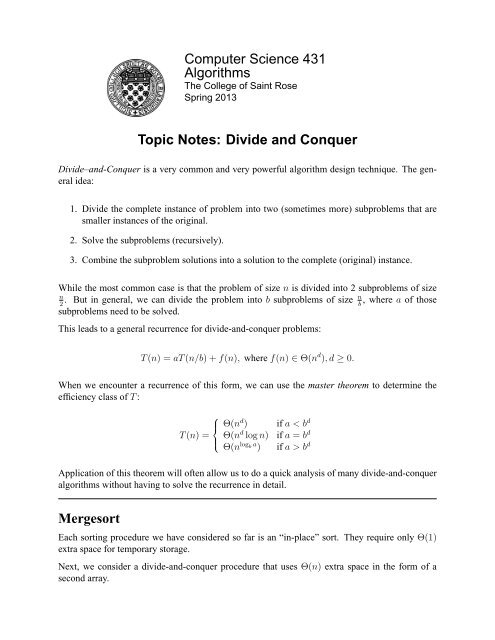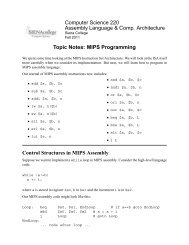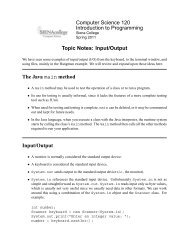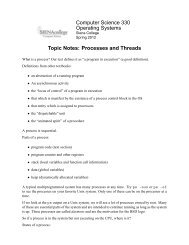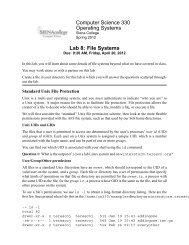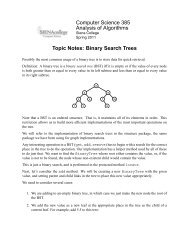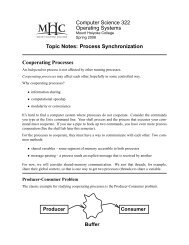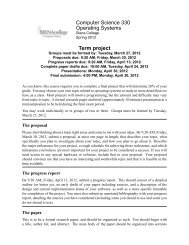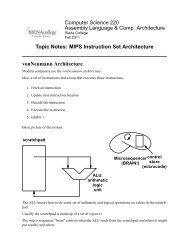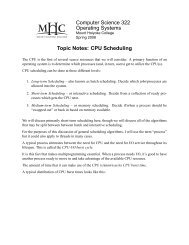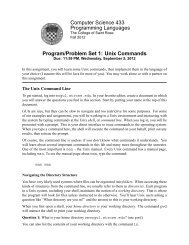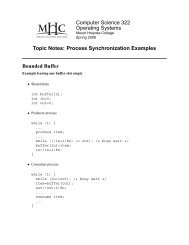Topic Notes: Divide-and-Conquer Algorithms - Courses
Topic Notes: Divide-and-Conquer Algorithms - Courses
Topic Notes: Divide-and-Conquer Algorithms - Courses
Create successful ePaper yourself
Turn your PDF publications into a flip-book with our unique Google optimized e-Paper software.
Computer Science 431<strong>Algorithms</strong>The College of Saint RoseSpring 2013<strong>Topic</strong> <strong>Notes</strong>: <strong>Divide</strong> <strong>and</strong> <strong>Conquer</strong><strong>Divide</strong>–<strong>and</strong>-<strong>Conquer</strong> is a very common <strong>and</strong> very powerful algorithm design technique. The generalidea:1. <strong>Divide</strong> the complete instance of problem into two (sometimes more) subproblems that aresmaller instances of the original.2. Solve the subproblems (recursively).3. Combine the subproblem solutions into a solution to the complete (original) instance.While the most common case is that the problem of size n is divided into 2 subproblems of sizen. But in general, we can divide the problem into b subproblems of size n , where a of those2 bsubproblems need to be solved.This leads to a general recurrence for divide-<strong>and</strong>-conquer problems:T(n) = aT(n/b)+f(n), where f(n) ∈ Θ(n d ),d ≥ 0.When we encounter a recurrence of this form, we can use the master theorem to determine theefficiency class of T :⎧⎪⎨ Θ(n d ) if a < b dT(n) = Θ(n d logn) if a = b d⎪⎩Θ(n log b a ) if a > b dApplication of this theorem will often allow us to do a quick analysis of many divide-<strong>and</strong>-conqueralgorithms without having to solve the recurrence in detail.MergesortEach sorting procedure we have considered so far is an “in-place” sort. They require only Θ(1)extra space for temporary storage.Next, we consider a divide-<strong>and</strong>-conquer procedure that uses Θ(n) extra space in the form of asecond array.
CSC 431 <strong>Algorithms</strong> Spring 2013It’s based on the idea that if you’re given two sorted arrays, you can merge them into a third inΘ(n)time. Each comparison will lead to one more item being placed into its final location, limiting thenumber of comparisons ton−1.In the general case, however, this doesn’t do anything for our efforts to sort the original array. Wehave completely unsorted data, not two sorted arrays to merge.But we can create two arrays to merge if we split the array in half, sort each half independently,<strong>and</strong> then merge them together (hence the need for the extra Θ(n) space).If we keep doing this recursively, we can reduce the “sort half of the array” problem to the trivialcases.This approach, the merge sort, was invented by John von Neumann in 1945.How many splits will it take? Θ(logn)Then we will haveΘ(logn) merge steps, each of which involves sub-arrays totaling in size ton, soeach merge (which will bek independent merges into n -element arrays) step hasΘ(n) operations.kThis suggests an overall complexity of Θ(nlogn).Let’s look at pseudocode for this:mergesort(A[0..n-1])if n>1copy first half of array A into a temp array Bcopy second half of array A into a temp array Cmergesort(B)mergesort(C)merge(B <strong>and</strong> C into A)where the merge operation is:merge(B[0..p-1], C[0..q.1], A[0..(p+q-1)])while B <strong>and</strong> C have more elementschoose smaller of items at the start of B or Cremove the item from B or Cadd it to the end of Acopy remaining items of B or C into ALet’s do a bit more formal analysis of mergesort. To keep things simple, we will assume thatn = 2 k .Our basic operation will be the number of comparisons that need to be made.The recurrence for the number of comparisons for a mergesort of a problem of size n = 2 k isC(n) = 2C(n/2)+C merge (n) for n > 1,C(1) = 0.2
CSC 431 <strong>Algorithms</strong> Spring 2013The best, worst, <strong>and</strong> average cases depend on how long we are in the main while loop in the mergeoperation before one of the arrays is empty (as the remaining elements are then taken from theother array with no comparions needed). Let’s consider the worst case, where the merge will taken−1 comparisons (one array becomes empty only when the other has a single element remaining).This leads to the recurrence:C worst (n) = 2C worst (n/2)+n−1 for n > 1,C worst (1) = 0.The master theorem, gives is that C worst (n) ∈ Θ(nlogn).QuicksortAnother very popular divide <strong>and</strong> conquer sorting algorithm is the quicksort. This was developedby C. A. R. Hoare in 1962.Unlike merge sort, quicksort is an in-place sort.While merge sort divided the array in half at each step, sorted each half, <strong>and</strong> then merged (whereall work is in the merge), quicksort works in the opposite order.That is, quicksort splits the array (which takes lots of work) into parts consisting of the “smaller”elements <strong>and</strong> of the “larger” elements, sorts each part, <strong>and</strong> then puts them back together (trivially).It proceeds by picking a pivot element, moving all elements to the correct side of the pivot, resultingin the pivot being in its final location, <strong>and</strong> two subproblems remaining that can be solvedrecursively.A common <strong>and</strong> simple choice for the pivot is the leftmost element. We put it into its correctposition <strong>and</strong> put all elements on their correct side of the pivot.Psuedocode for a quicksort:quicksort(A[l..r]) // we would start with l=0, r=n-1if l < rs = partition(A[l..r]) // s is pivot’s locationquicksort(A[l..s-1])quicksort(A[s+1..r])partition(A[l..r])p = A[l] // leftmost is pivoti = l; j = r+1dodo i++ until i = r || A[i] >= pdo j-- until j = l || A[j] =jswap(A[i],A[j]) // undo last3
CSC 431 <strong>Algorithms</strong> Spring 2013swap(A[l],A[j]) // swap in pivotreturn jNote: we always make a recursive call on a smaller array (but it’s easy to make a coding mistakewhere it doesn’t, <strong>and</strong> then the sort never terminates).The complexity of quicksort is harder to evaluate than merge sort because the pivot will not alwayswind up in the middle of the array (in the worst case, the pivot is the largest or smallest element).Again, the basic operation will be the comparisons that take place in the partition.The partition method is clearly Θ(n) because every comparison results in left or rightmoving toward the other <strong>and</strong> quit when they cross.In the best case, the pivot element is always in the middle.This would lead to a number of comparisons according to the recurrence:C best (n) = 2C best (n/2)+n for n > 1, C best (1) = 0.By solving the recurrence or applying the Master Theorem, we find that C best (n) ∈ Θ(nlogn),exactly like merge sort.In the worst case the pivot is at one of the ends <strong>and</strong> quicksort behaves like a selection sort. Thisoccurs with already-sorted input or reverse-sorted input. To analyze this case, think of the firstpass through the full n-element array. The first element, A[0], is chosen as the pivot. The leftto-rightinner loop will terminate after one comparison (since A[0] is the smallest element). Theright-to-left inner loop will perform comparisons with A[n-1], A[n-2], ... all the way down toA[0] since we need to “move” the pivot item to its own position. That’sn+1 comparisons for thepartition step. In the process, the problem size is decreased by 1, so there will bencomparisons inthe next step,n−1 in the third, <strong>and</strong> so on. We stop after processing the two-element case (requiring3 comparisons), so the total comparisons is given by:C worst (n) = (n+1)+n+···+3 = (n+1)(n+2)2−3 ∈ Θ(n 2 )A careful analysis can show that quicksort is Θ(nlogn) in the average case (under reasonableassumptions on distribution of elements of array). We can proceed by assuming that the partitioncan occur at any position with the same probability ( 1 ). This leads to a more complex recurrence:nC avg (n) = 1 nn−1 ∑s=0[(n+1)+C avg (s)+C avg (n−1−s)] for n > 1,C avg (0) = 0,C avg (1) = 0.We will not solve this in detail, but it works out to:C avg (n) ≈ 2nlnn ≈ 1.38nlog 2 n ∈ Θ(nlogn).4
CSC 431 <strong>Algorithms</strong> Spring 20133. postorder: visit the left subtree, then visit the right subtree, then visit the root.Pseudocode is staightforward, for example:inorder(T)if (T is not empty)inorder(T.left)visit(T.root)inorder(T.right)Analysis is similar to that of height for this <strong>and</strong> for preorder <strong>and</strong> postorder. Each node is visitedonce.Strassen’s Matrix MultiplicationOur text describes a divide <strong>and</strong> conquer multiplication of large numbers, but since you likely sawthat in discrete math, we will move along to consider Strassen’s matrix-matrix multiplication.This algorithm improves upon the st<strong>and</strong>ard matrix-matrix multiplication by observing that theproduct of two2×2 matrices can be performed using 7 multiplications instead of the usual 8.This in itself does not seem that significant, especially when we consider that the st<strong>and</strong>ard algorithmrequires 4 additions, while Strassen’s algorithm requires 18 additions/subtractions.The real benefit comes when we apply this idea to get a divide-<strong>and</strong>-conquer algorithm for multiplyingmatrices. To multiply 2n×n matrices, we break it into 4 n× n matrices <strong>and</strong> use Strassen’s2 2algorithm to multiply them.Our recurrence for the number of multiplications with this approach:M(n) = 7M(n/2) for n > 1, M(1) = 1.From which the Master Theorem (or a backward substitution) will yield:M(n) ∈ Θ(n log 2 7 ) ≈ n 2.807 .Which is definitely a slower rate of growth than Θ(n 3 ).An analysis of the (larger) number of additions/subtractions results in the same efficiency class:A(n) ∈ Θ(n log 2 7 ).Many other approaches have been invented with even smaller rates of growth than Strassen’s algorithm,but most have constant factors that make them impractical for real usage.Computational Geometry6
CSC 431 <strong>Algorithms</strong> Spring 2013We return to two familiar problems from computational geometry to explore divide-<strong>and</strong>-conquersolutions that are more efficient than the brute force approaches considered previously.Closest PairsOur problem is to find among a set of points in the plane the two points that are closest together.We begin by assuming that the points in the set are ordered by increasing x coordinate values. Ifthis is not the case, the points can certainly be sorted in O(nlogn) time as a preprocessing step.We then divide the points into two subsets, S 1 <strong>and</strong> S 2 , each of which contains n points (which is2easy since the points are sorted byxcoordinate).We then recursively find the closest pair of points in each subsetS 1 <strong>and</strong>S 2 . If the distance betweenthe closest pair in S 1 = d 1 <strong>and</strong> the distance between the closest pair in S 2 = d 2 . We then knowthat d = min{d 1 ,d 2 } is an upper bound on the minimum distance between any pair, but we stillneed to make sure we check for shorter distances where one point is inS 1 <strong>and</strong> the other is in S 2 .The only points which might be closer together than distance d are those within a strip of width dfrom the dividing line between the subsets. For each point within that strip <strong>and</strong> within one subset,we potentially need to consider all points from within the strip within the other subset. That stillsounds like a lot of work. The key observation is that for each point on one side, we have toconsider points whose y coordinates are within d. This will mean at most 6 points from the otherside, since if there are more points than that within d in the y coordinate on the other side, at leastone pair from among that point would be closer than distance d to each other.So how do we find those points to check? They can be found quickly if we also keep the pointssorted in order by y coordinate. Still, this seems difficult but it can be done efficiently (see thetext’s description for details).We end up with a recurrence:T(n) = 2T(n/2)+O(n)which given an overall time of T(n) ∈ O(nlogn).QuickhullThe other computational geometry problem discussed in the text is called quickhull – an algorithmfor finding the convex hull of a set of points. We will not discuss it in class, but it is worth reading.7


